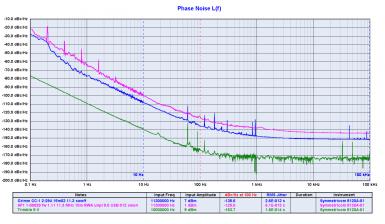Some new phase noise measurment gear finally arrived, so we are willing to take a look at any and all digital audio clocks that members would like to send in. Please PM for the details... and see example below. Now you'll know... What we're finding is that some clocks have good high-frequency phase noise, which is relatively easy to do, but the low frequency phase noise isn't so hot. The lower offset regime is apparently critical for realism, presence, soundstaging and the like, but we don't have any engineering model yet for why this would be so.
The clock needs to have a 256 Fs output (meaning, typically, a bit clock or "Super Clock" output. The phase noise device can only go down to about 1 MHz, which is substantially above even a 384 kHz word clock.
If you send me the model of your product, we can double-check to see if our present gear can handle it.
And in a few weeks, we should be able to do elaborate jitter measurements as well.
The clock needs to have a 256 Fs output (meaning, typically, a bit clock or "Super Clock" output. The phase noise device can only go down to about 1 MHz, which is substantially above even a 384 kHz word clock.
If you send me the model of your product, we can double-check to see if our present gear can handle it.
And in a few weeks, we should be able to do elaborate jitter measurements as well.














